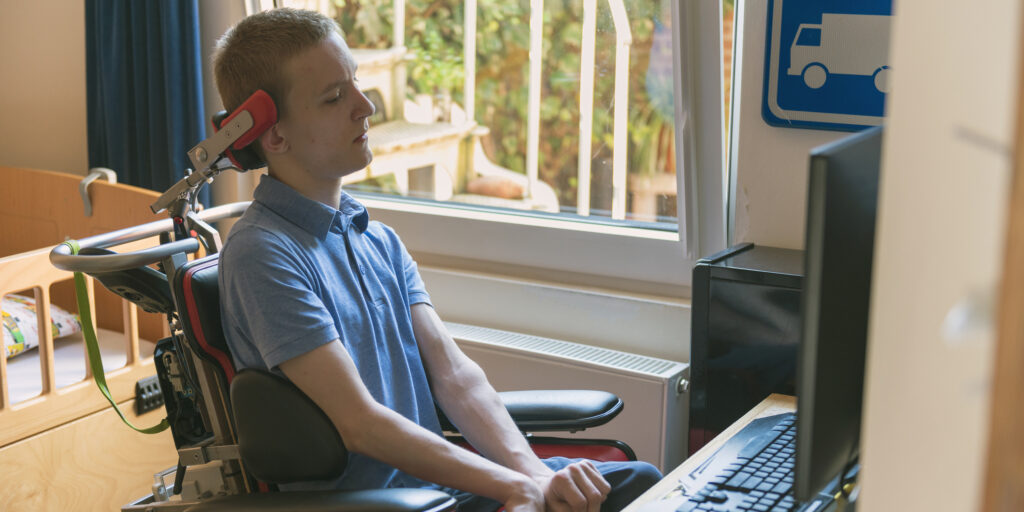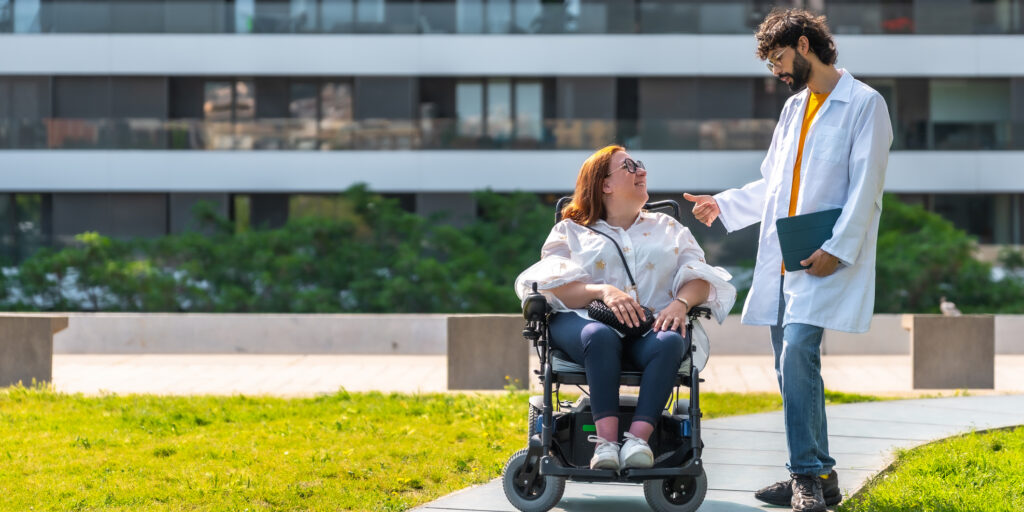
Simply Stated: Updates in Collagen VI-Related Dystrophy
By Sujatha Gurunathan | Saturday, January 6, 2024
5 Second Summary
“Simply Stated” is a Quest column designed to explain some terms and basic facts about neuromuscular diseases.
Find more at Mdaquest.org/tag/simply-stated
Collagen VI-related dystrophy (COL6-RD) is a rare genetic muscle disease caused by defects in one of three genes that form a triple helix protein (collagen VI) found in the extracellular matrix (ECM) between cells. Pathogenic mutations cause instability in the ECM of muscle and other tissues, resulting in varying degrees of muscle weakness, joint contractures, and other symptoms. COL6-RD is a spectrum disorder that includes Bethlem myopathy, intermediate COL6-RD, and Ullrich congenital muscular dystrophy (UCMD). Although the exact prevalence of the COL6-RD is not known given the complex nature of inheritance, it is most likely to be similar to that of LAMA2-related dystrophy, which has been estimated to be 8.3 cases per million.
Symptoms of COL6-RD
COL6-RD was originally thought to be two separate conditions, but is now known to be a single genetic condition with a broad spectrum of symptoms and progression. Affected individuals tend to have normal to high intelligence, and creatine kinase (CK) levels are typically normal to mildly elevated. The use of traditional nomenclature (Bethlem muscular dystrophy, UCMD) is still used clinically to help determine diagnosis and prognosis.
Bethlem muscular dystrophy
Bethlem muscular dystrophy is on the milder end of the COL6-RD spectrum, with symptoms that may not present until later in childhood or even early adulthood. Symptoms typically progress more slowly and affected individuals frequently retain the ability to walk throughout adulthood. Those with Bethlem muscular dystrophy may experience:
- Delayed motor milestones and proximal muscle weakness
- Joint contractures (tightening/shortening) of joints in elbows, Achilles tendons, and long finger flexors
- Skin features including keratosis pilaris, keloid and/or “cigarette-paper” scarring
Intermediate COL6-RD
Affected individuals with intermediate COL6-RD present with symptoms at or soon after birth. Disease progression may result in loss of ambulation and the need for nocturnal noninvasive ventilation (BiPAP) in middle to late childhood or early adulthood. Symptoms often include:
- Delayed or missed motor milestones
- Torticollis (stiff neck) and hip dislocation at birth
- Proximal muscle weakness (trunk, hips, upper arms and legs)
- Joint Contractures (long finger flexors, elbows, ankles, and shoulders)
- Mild to moderate rigid spine and scoliosis (spine curvature)
- Distal joint hyperlaxity (bendy fingers)
- Skin features including keratosis pilaris, keloid and/or “cigarette-paper” scarring
- Possible erythema (superficial skin reddening) over cheeks
Ulrich congenital muscular dystrophy (UCMD)
UCMD falls on the more severe end of the COL6-RD spectrum. Affected individuals present with symptoms at or soon after birth, and may never gain the ability to walk or may lose ambulation in early childhood. Severe respiratory insufficiency occurs in all affected individuals, requiring nocturnal noninvasive ventilation (BiPAP) in early to middle childhood, and in some the need for daytime breathing support by early adulthood. Symptoms often include:
- Delayed or missed motor milestones
- Torticollis (stiff neck), hip dislocation, and abnormal positioning of hands and feet at birth
- Muscle weakness
- Joint contractures (long finger flexors, elbows, ankles, and shoulders)
- Early rigid spine, scoliosis and kyphosis (spine curvature)
- Distal joint hyperlaxity (bendy fingers)
- Skin features including keratosis pilaris, keloid and/or “cigarette-paper” scarring
- Erythema (superficial skin reddening) over cheeks
For more detailed information about the signs and symptoms, as well as diagnosis, prognosis and care management concerns, an in-depth review can be found from Foley, et al.
Cause of COL6-RD
COL6-RD is caused by mutations in one of three genes: COL6A1, COL6A2, COL6A3. These genes provide the blueprints for the collagen VI protein, which helps anchor muscle, skin, and cartilage tissues to the ECM, the scaffolding complex that surrounds and supports cells. Disease-causing mutations either prevent production of the collagen VI protein, or cause production to be abnormal, thereby impacting the structure and function of muscles and other tissues.
Genetic changes that cause COL6-RD can be inherited in an autosomal recessive pattern (requires two copies of the defective gene) or an autosomal dominant pattern (requires one copy of the defective gene). In a number of cases, COL6-RD occurs spontaneously (de novo mutation), without any known family history.
Diagnosis of COL6-RD
A COL6-RD diagnosis is typically based on a combination of clinical examination and genetic testing. Clinical observation of muscle weakness will typically lead to the ordering of a neuromuscular disease panel of genetic tests. This can detect probable or confirmed pathogenic mutations in the COL6A1, COL6A2, and COL6A3 genes, leading to a diagnosis of COL6-RD. In some cases, characteristic muscle changes seen by magnetic resonance imaging (MRI) and partial or complete absence of collagen VI seen by muscle biopsy can help confirm a COL6-RD diagnosis.
Current management of COL6-RD
While there is currently no cure or disease-modifying therapy for COL6-RD, proactive care management is critical to managing symptoms and disease progression, and improving overall health and quality of life. This includes:
- Beginning at age 4-6 years old, semi-annual respiratory surveillance through pulmonary function testing, both sitting and supine, and annual sleep studies that include end tidal carbon dioxide monitoring
- Nocturnal non-invasive ventilation (BiPAP), as determined by respiratory testing, with the potential for daytime respiratory support later in life
- Physical therapy and occupational therapy to slow the progression of joint contractures
- Orthopedic surveillance and possible intervention for scoliosis and some joint contractures
- Feeding and nutritional support to address failure to thrive
Evolving research and treatment landscape
While the current standard of care is proactive symptom management, research advances and the promise of therapeutic development on the horizon offer hope for people living with COL6-RD. Preclinical research by a number of clinician scientists is (1) contributing to our understanding of the genetic and cellular mechanisms underlying these conditions, (2) helping to identify outcome measures for use in future clinical trials, and (3) beginning development of therapeutic candidates that may slow or reverse the progression of the COL6-RD. Notable researchers in the COL-RD field include, Dr. Carsten Bonnemann (National Institutes of Health), Dr. A. Reghan Foley (National Institutes of Health), Dr. Francesco Muntoni (University College London), Dr. Valerie Allamand (Institute of Myology, Paris), Dr. Paolo Bonaldo (University of Padova, Italy), and Dr. Russell Butterfield(University of Utah), among others.
Observational studies and patient registry opportunities are also underway to better understand the disease course of the COL6-RD and identify outcome measures for clinical trials. Registries that are currently enrolling include:
· Congenital Muscle Disease International Registry (Cure CMD)
· Global Registry for COL6-related Dystrophies (Newcastle-upon-Tyne Hospitals NHS Trust)
To learn more about research and clinical study opportunities in COL6-RD, visit clinicaltrials.gov and use key search terms such as “COL6-related dystrophy,” “Bethlem muscular dystrophy,” or “Ullrich congenital muscular dystrophy” in the condition or disease field. The Congenital Muscle Disease International Registry also maintains a current study list, and completing registration in the CMDIR will ensure you are notified of potential opportunities to participate in studies and trials.
MDA’s work to further cutting-edge COL6-RD research
MDA is committed to furthering research in and therapeutic development for COL6-RD. Since its inception, MDA has supported a number of efforts to better understand the disease-causing processes that contribute to this condition and design therapeutic strategies to counter them. Recent MDA-funded studies into new therapies include:
Exon-skipping therapy for Ullrich congenital muscular dystrophy (2017-2022)
Veronique Bolduc, National Institute of Neurological Disorders and Stroke, NIH NINDS
In this project, the investigators attempted to generate an “exon-skipping” therapy for UCMD, and test it in an animal model of the disease. At the time, this type of therapy was already approved for use to treat another neuromuscular disease, Duchenne muscular dystrophy (DMD). The investigators designed the therapy to target and promote skipping over a section of genetic code in order to avoid the collagen VI gene mutation, leading to increased production of the corrected form of collagen VI protein.
Suppression of COL6 premature termination codons by anticodon-edited tRNAs (2021-2022)
Dr. Valerie Allamand, Sorbonne Université-Inserm
In this project, the investigators tested the use of viral vectors to deliver a particular therapy (engineered transfer RNA) into cells from people with COL6-RD caused by a particular type of mutation known as a nonsense mutation. This mutation prematurely terminates the building of the protein, resulting in non-functional, truncated collagen VI proteins. The investigational therapy was designed to overcome the nonsense mutation and restore production of functional collagen VI.
Together, these and other studies have helped researchers to better understand COL6-RD and identify targets for therapeutic intervention. They are laying the groundwork for future clinical trials, improving prospects for better disease management for people living with COL6-RD.
We would like to thank staff at Cure CMD for their collaboration and contributions to this article.
Next Steps and Useful Resources
- To learn more about research and clinical study opportunities in UCMD, visit clinicaltrials.gov.
- MDA’s Resource Center provides support, guidance, and resources for patients and families, including information about COL6-related muscular dystrophy, open clinical trials, and other services. Contact the MDA Resource Center at 1-833-ASK-MDA1 or ResourceCenter@mdausa.org
- Additional resources for information about COL6-related muscular dystrophy include:
- Cure CMD – curecmd.org
- CMD Turkey – cmdtr.com
- Noelia Foundation (Spain) – fundacionnoelia.org
- COL6 Fund – col6fund.org
- NOA Project (their website is currently down unfortunately, based in Panama)
-
These additional organizations also offer COL6-specific programming and/or have funded research grants in COL6:
- AFM Telethon (France) – afm-telethon.com
- Muscular Dystrophy UK – musculardystrophyuk.org
- Muscular Dystrophy Canada – muscle.ca
- German Association for Muscle Diseases – dgm.org
- Italian Muscular Dystrophy Association (UILDM) – uildm.org
- Muscular Dystrophy Australia – mda.org.au
- The Speak Foundation (for those with COL6 mutations that have been diagnosed with LGMDR22 or LGMDD5, though Cure CMD also supports these individuals) – thespeakfoundation.com
- Stay up-to-date on Quest content! Subscribe to Quest Magazine and Newsletter.
Disclaimer: No content on this site should ever be used as a substitute for direct medical advice from your doctor or other qualified clinician.




